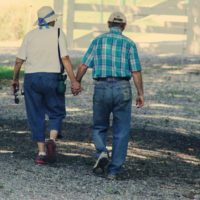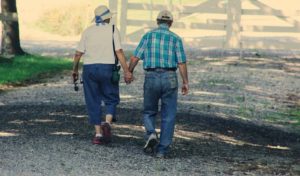Blog

I’m a Nursing Home Psychologist in the Pandemic Epicenter
I’m Worried About the Emotional Impact on the Staff
Mr. Davis used to sit in the lobby and greet staff members when they walked in the door of the nursing care center. His wife had friendly chats with other residents when she came to visit; his children brought plates of homemade cookies to the nursing station during the holidays. Covid-19 took him, them and every other family from nursing homes during this pandemic.
His bed is now occupied by Mr. Ward, who was transferred from the hospital two days ago with a coronavirus diagnosis. He hasn’t seen his relatives in the three weeks since they brought him to the crowded emergency room and his cell phone disappeared somewhere along the way. Lonely and in distress, he calls for help from overwhelmed nurses and aides many times each shift.
The care team swiftly referred Mr. Ward to me for psychology services. I’m able to sit down with him, ease his isolation and begin to process his traumatic experiences. I put my mobile phone on speaker so that he can talk with his children. His requests for nursing assistance have decreased.
For over two decades, I’ve tended to the emotional needs of residents, families and staff as a psychologist in nursing homes in the New York Metropolitan area. The mental health consequences of this pandemic on those who live and have loved ones in nursing facilities are profound. Tragic tales of family members unable to visit dying relatives are increasing, and, when the homes open up again to visitors, we will undoubtedly learn of many more heartbreaking experiences.
No less deserving of attention are the emotional pressures on the front-line workers caring for fragile and aging residents.
For the entire article, visit:
I’m a Nursing Home Psychologist in the Pandemic Epicenter

Grim but unwavering: Notes from the COVID-19 epicenter
I live in New York City, the COVID-19 epicenter of the U.S. There are long lines for the few open supermarkets, the parks are closed and the nursing homes in New York are now mandated to accept COVID residents from local hospitals.
I’m in touch with psychologist colleagues from around the area. Some facilities have personal protective equipment for their staff regardless of whether or not they have known COVID cases; others are less prepared and less open with their staff about the coronavirus, increasing the anxiety level of their team members.
I was relieved to see the McKnight’s headline last week, “Trump wants masks on all nursing home workers, temperature checks for all, and separate COVID-19 units.” Finally, I thought to myself. Perhaps facilities in other parts of the country will be spared what we’re going through in New York, where the regulations trailed the virus and 1 in 4 facilities have COVID residents as of last week’s reports. It is, in a word, grim.
To get through, I’m trying to focus on being of service, when I can focus at all.
I’ve been issued an N95 mask and a face shield, and I receive a daily surgical mask. I purchased a cane that folds out into a seat so I can maintain a safe distance from my residents and avoid sitting on anything in their rooms. I put my phone in a plastic pouch that hangs from my neck, for easy access and easy cleaning. I obsessively sanitize my hands. At the end of the day, I wipe down anything reusable.
Despite my frightening garb, my patients are happy to see me. “I’ve been waiting for you!” one man exclaimed. “I have to talk to you.”
For the entire article, visit:
Grim but unwavering: Notes from the COVID-19 epicenter


AARP: Navigating New Rules for Visiting Nursing Home Residents Near Death
Thank you to Bruce Horovitz and AARP for tackling this painful aspect of resident care during Covid-19 and for mentioning my work.
Navigating New Rules for Visiting Nursing Home Residents Near Death
Coronavirus restrictions to protect our most vulnerable alter end-of-life rituals
After 45 years of marriage, the cruel twists of fate now leave Jean Ross and her seriously ailing husband, Phil, sadly hoping for a best-case scenario, under which they would be able to see each other without waiting for weeks, months or even longer.
It would be the best case because it could potentially be deadly if Phil, 69, were to catch the coronavirus in his current condition.
Phil is convalescing at a rehab facility in Alexandria, Virginia, following a series of six surgeries to amputate his right arm and right leg, necessitated by a serious allergic reaction to medications after an illness around Christmas. Jean has been barred from visiting him since the facility began following the Centers for Medicare & Medicaid Services’ (CMS) tough new coronavirus-related restrictions on visitors to nursing homes, hospitals and convalescent facilities.
“He’s weak as a kitten due to three months in bed and very little rehab,” says Jean, who also turns 70 this year and had been completing plans with Phil to retire and move from Vienna, Virginia, to live closer to their daughter in suburban Philadelphia, before he became ill. “I’m looking at a new reality. It was wrenching last night to say on the phone, ‘I don’t know when I’ll see you again.’ “
For the entire article, visit:
Navigating New Rules for Visiting Nursing Home Residents Near Death
Coronavirus restrictions to protect our most vulnerable alter end-of-life rituals


Addressing residents’ coronavirus fears
As the number of coronavirus cases increases around the world, providers may be worried about the emotional impact of the outbreak on residents and how to handle it. One would expect residents to be concerned, given that they’re at higher risk due to their ages, underlying health problems and residence in a communal setting.
Rather than mass panic, my experience and an informal query of my psychologist colleagues suggests that they may not be as worried as you’d think. As of last week, remarkably few of them have raised the issue in psychotherapy sessions (where uneasiness of every kind is discussed).
My colleagues and I speculate that the majority of residents are not unduly alarmed about the situation due to a combination of factors: more pressing problems, successful passage through many prior hardships, fatalism (i.e., “At this age, something’s going to get me”), denial (“it’s happening far away”), and trust that the facility will keep them safe.
Nevertheless, despite their general calm and resilience, it’s perfectly reasonable for residents to have questions and concerns. There will be some who are deeply unsettled by the prospect of the virus, particularly those with anxiety disorders and people struggling with depression. There may also be individuals who have had past traumatic experiences with hospital-acquired infections, isolation precautions, or communicable illnesses such as polio.
Facilities are no doubt reviewing infection control procedures and holding staff education sessions for their employees. To address the emotional needs of residents, add a brief segment to staff training that includes the following suggestions:
- Limit the amount of time residents spend watching the news. There’s no need for them to be exposed to hours of alarming reports on the day room television.
For the entire article, visit: Addressing residents’ coronavirus fears

A look at Germany’s intriguing long-term care system
 I was in Berlin, Germany, last week and did some research into their long-term care system during my visit. I was curious about how it might be different or similar to ours, given the country’s national healthcare program.
I was in Berlin, Germany, last week and did some research into their long-term care system during my visit. I was curious about how it might be different or similar to ours, given the country’s national healthcare program.
Briefly, the German system has public and private healthcare insurance options and 100% of the population has coverage. That’s compared to the 28 million Americans without insurance and the 48% of Americans between ages 19 and 64 who are underinsured1. Private insurers in Germany are not profit-making enterprises and people cannot be turned away for pre-existing conditions. There are caps on charges for services so that healthcare is still affordable even when medical needs increase. They have better health outcomes than the U.S., and at significantly lower costs.2
The system has financial incentives for exercise and regular medical checkups, rather than cost-prohibitive copayments that can lead to delays in medical attention.
Long-term care insurance
About 79 million of Germany’s 82 million people have long-term care insurance, composed of 88% public and 12% private insurance.3 Payments can be used for care at home, given to professional, family or friend caregivers, or applied to one of the 12,000 care facilities in the country. If the insurance payment, along with pensions and other income, isn’t enough to cover facility costs, then families contribute or the elder applies for social assistance.
Exploring LTC in Berlin
I had dinner with Ilse Biberti, an actor and director who authored a best-selling German-language book on the six years she spent caring for her aging parents. I chatted about parents with middle-aged Germans over birthday cake at a party. And I got an informative tour of the aforementioned nursing home by Amélie Herberhold, one of its social workers.
I was staying in a friend’s sixth-floor walkup apartment. This wasn’t an anomaly; there were walkup apartments all over the city. “What do the old folks do?” I queried everyone I met. The answer: “They put a chair on each landing and they take their time.” This sounded very much like apartments in New York City, with elders somehow managing to walk up too many stairs until it’s no longer possible.
Journalist Johannes Buck shared an idea he had come across for those unable to reside alone. Multiple families bring their older relatives to live together in one home and then share the care for all of them as a collaborative effort. The concept of cooperative family responsibilities could be a welcome step on a continuum of care for some organizations or communities in the U.S.
For the entire article, visit:
A look at Germany’s intriguing long-term care system

LTC leaders gain remarkable insights from the Sleepover Project
 In my first year as a nursing home psychologist, I entered a resident’s room for a session and she invited me to have a seat in her wheelchair, the only surface that was clean and free of belongings. The thought of sitting in a wheelchair freaked me out. Instead, I carried a heavy chair from the day room up and back down the long hallway.
In my first year as a nursing home psychologist, I entered a resident’s room for a session and she invited me to have a seat in her wheelchair, the only surface that was clean and free of belongings. The thought of sitting in a wheelchair freaked me out. Instead, I carried a heavy chair from the day room up and back down the long hallway.
Afterward I contemplated my reflexive fear of that wheelchair. I concluded that my reaction wasn’t about infection control but rather a superstitious belief that I could somehow jinx myself by sitting there. It separated me from her experience and didn’t offer me any protection from the human reality that any one of us could wind up in that chair tomorrow.
I suspect that fear is a primary reason why it’s rare for long-term care leaders to spend a night in their own facilities, despite the wealth of information they could glean about their enterprises from doing so.
Overcoming such apprehensions, trailblazers in this area joined Laura Beck, the Eden Alternative Learning & Development guide, to discuss their experiences with The Sleepover Project on a webinar that is now available on demand here. It will be followed by an upcoming mini-course on how to create a Sleepover Project in other organizations. (Sign up here for the Eden Alternative newsletter to stay informed about the launch date.)
The webinar featured Jill Vitale-Aussem, president and CEO of the Eden Alternative, and Patricia McBride, the VP of Clinical and Compliance at Christian Living Communities/Cappella Living Solutions based out of Denver.
During the course of her career, Vitale-Aussem spent several nights in different LTC facilities in which she has been, variously, a nursing home administrator, CCRC executive director and vice president of operations. McBride convinced her entire leadership team to each spend a night as a resident over one summer.
McBride noted that, with continued promotions, organizational leaders were moving further and further from the day-to-day experience of what it meant to be living and working within the setting. Calling it a “collective empathy experience,” they envisioned this opportunity as a way to increase their understanding of their residents and staff, and to determine what, if any, improvements needed to be made to their facilities. The leaders gleaned more insights through staying one night in their communities than they could have imagined.
For the entire article, visit:
LTC leaders gain remarkable insights from the Sleepover Project

And the Oscar goes to…
And the Oscar goes to…
The Oscars kind of bug me. In the gloom of winter, it can be hard not to notice that the extravaganza is filled with self-congratulatory workers wearing clothes that cost more than the yearly salary of several nursing aides.
Rather than stew, however, about the puzzling priorities of the world, I’ve decided to award my own Oscars.
Drum roll, please…
The award for best Costume Design goes to those workers who rock their uniforms. Holiday-themed ensembles, crisply starched tops, well-groomed hair and a kind attitude all speak volumes about the people who wear them, the pride they take in their work and their willingness to help elders.
Best Production Design goes to the maintenance departments, who manage to keep facilities functioning on an essential level and ensure that the surroundings look top-notch. From repairing air conditioners to fixing dresser drawers to rectifying all the many behind-the-scenes glitches, the maintenance crews renew well-worn buildings, creating inviting, trustworthy foundations for care.
Best Foreign Language Film goes to CMS for their efforts to provide guidance to long-term care operators and staff.
Best Original Score goes to the recreation staff who tirelessly provide musical entertainment, engaging activities and meaningful pursuits in a setting more focused on the health of bodies than on that of minds and hearts. Therapeutic recreation is the soundtrack in the lives of residents.
Best Makeup and Hairstyling goes to the aides who thoughtfully tend to the appearance of their charges, helping residents feel worthy of personal attention and more like their best selves in a frequently impersonal environment. A shout-out to the barbers and hairdressers who come into facilities and work their magic for modest fees for people in need.
Best Documentary Feature goes to the geropsychologists who spend their days talking with seniors about their lives, their loves and their losses, assisting them in navigating medical problems, end of life issues, family concerns and institutional living.
Best Visual Effects goes to the housekeeping staff who transform trashed rooms into sparkling accommodations, keeping residents, families and staff free from contagion and healthcare-associated infections.
For the entire article, visit: And the Oscar goes to…

A resolution to serve physical and mental health
A resolution to serve physical and mental health
Ah, January — a moment to consider plans and directions for the upcoming months. Like many people, one of my personal goals is to recommit to mindful eating and wise food choices. While some residents like to rethink their diets as a New Year’s resolution, there are good clinical reasons to review the facility’s menu at any time of the year.
Researchers have found that the diet and the stomach microbiomes of those in long-term care are significantly less diverse and healthy than those of community-based elders, with institutionalized elders eating diets that are higher in fat and lower in fiber.
Not only that, but the alteration in gut microbes are detectable within 24 hours of dietary changes, suggesting an immediate payoff to dietary improvements (and immediate deleterious effects).
Benefits of a diverse menu
Studies indicate that a more diverse, healthier menu can promote healing, reduce inflammation and help to fight infection. Moreover, there’s a line of research suggesting that the foods we eat influence not just physical health, but also mental health and moods. A healthy gut microbiome is associated with better cognition and reduced anxiety, depression and other emotional maladies.
“The tried-and-true advice of a high-fiber, low-sugar, mostly plant-based diet can benefit patients in body and mind,” author Kirsten Weir writes in “The Future of Psychobiotics” (Monitor on Psychology, December 2018).
For the entire article, visit: A resolution to serve physical and mental health

Getting ‘hygge’ with it, at the holidays and year-round
Getting ‘hygge’ with it, at the holidays and year-round
I know, I know, that’s not how the word is pronounced. But as soon as I read about the Danish concept of coziness, I got that darn Will Smith song (“Gettin Jiggy With It”) in my head and I can’t get it out.
Hygge (actually pronounced “hyoo-guh”) refers to the creation of a comforting, convivial environment. Think hot cocoa, warm blankets and crackling fireplaces, with loved ones.
It sounds so charming that I resolved to apply hygge to an upcoming vacation. I decided to mix local sightseeing with a few days saved for the pleasures of cooking, reading a book and watching movies with an occasional bowl of popcorn under a comforter with my family. And, of course, I considered how the idea could be applied to long-term care facilities.
Nursing homes, which could generally do with an increased focus on “home” over “nursing,” have many reasons and opportunities to add some hygge.
First and foremost is the chance to “flip the script” about being in a confined environment. Residents who have infrequent opportunities to get outside under the best of circumstances and even fewer chances during inclement weather, often feel depressed or resentful regarding their confinement. Practicing hygge offers a mental shift from a perception of restriction to one of comfort.
Holiday hygge
During the holidays, residents may observe peers going out for day passes and family members arriving for visits. For those without passes or visitors, using hygge concepts can ease their emotional pain in a kind, simple manner that emphasizes their belonging to a group.
While holiday activities such as seasonal movies and Christmas caroling are wonderful, a hygge approach would suggest adding periods of quieter comforts such as lap blankets, a fireplace video and a story read aloud. Some people might enjoy crocheting or drawing during this communal activity. If the kitchen sent up a batch of warm cookies, so much the better.
Staff hygge
Residents may not be the only ones less-than-thrilled about being at the facility on a holiday. While many staff members consider their LTC jobs a calling and are gracious about being of service to elders on Christmas or New Year’s Eve, others may be disgruntled with the holiday shift and may “leak” their emotions to their charges.
A hygge approach can soften staff resentment.
For the entire article, visit:
Getting ‘hygge’ with it, at the holidays and year-round


The Minister for Loneliness in LTC
The Minister for Loneliness in LTC
According to researcher Julianne Holt-Lunstad of Brigham Young University, loneliness has a greater impact on health than smoking 15 cigarettes daily, or obesity, which is associated with 300,000 to 600,000 deaths a year in the United States alone.
In England, the “loneliness epidemic” has reached such proportions that they’ve appointed a Minister for Loneliness to address the problem.
This idea led me to consider the benefits of designating such a position in long-term care. Yes, we have recreation departments that encourage resident socialization, but a Minister for Loneliness could do so much more. The Minister also could target staff loneliness and the isolation of those in the community.
Minimizing staff loneliness has the potential to reduce turnover, alleviate staff stress and improve the culture of the organization. Seeking to decrease the isolation of those in the neighborhood would enhance the reputation of the facility as a community player and create a way for locals to connect with the home before they need it, so that it becomes a natural choice for later care.
Below are some ideas of ways in which the Minister for Loneliness could affect change (but there doesn’t need to be a formal role to try these suggestions).
For residents and their families, the minister could:
- Establish a communal table for residents interested in engaging with peers for a particular meal.
- Ensure that residents who needed hearing aids and other assistive devices had fully functioning equipment available.
- Train staff to facilitate like-minded friendships between residents, seating them together at meals and during activities.
For the entire article, visit: The Minister for Loneliness in LTC




